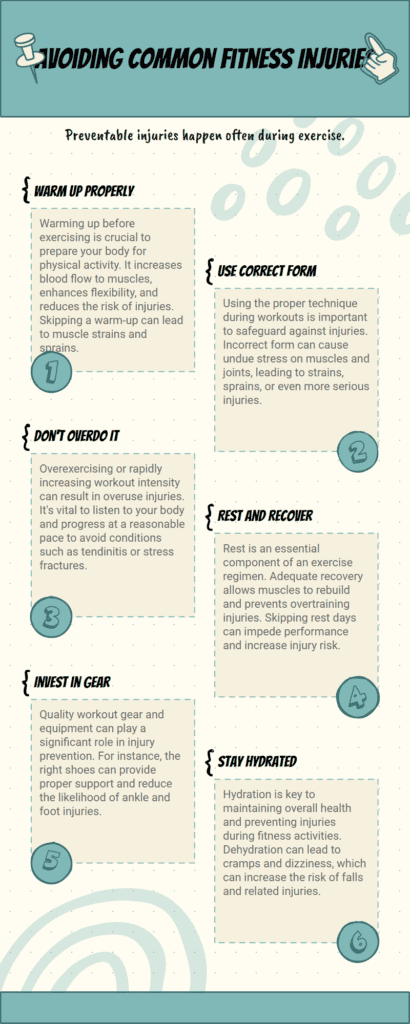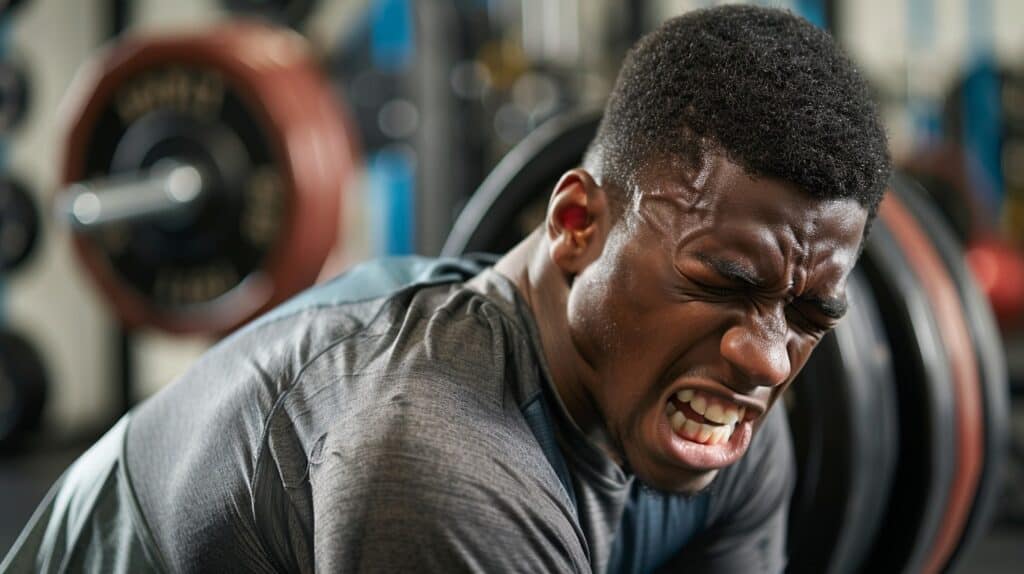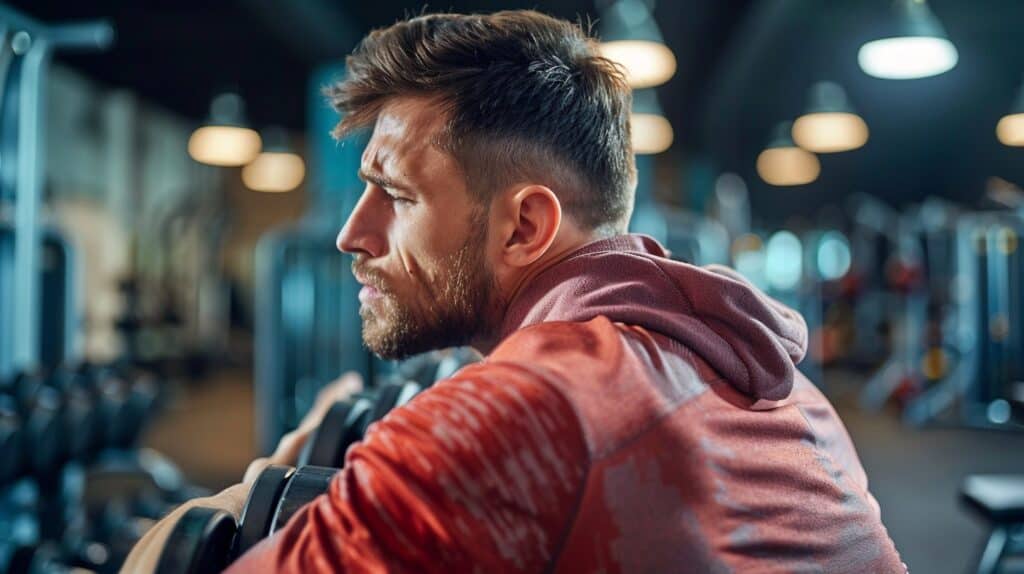Everyone wants to stay fit without getting hurt. Did you know that some fitness injuries are easy to prevent? This article will show you how to avoid common mishaps like sprains and shin splints.
Get ready for safe workouts.
Key Takeaways
Warm up before workouts and cool down after to prevent sprains, strains, and muscle cramps.
Choose the right shoes for your activity to avoid injuries like shin splints and runner’s knee.
Mix up exercise routines with cross-training and rest days to keep muscles strong without overuse.
Listen to your body’s signals for pain or discomfort and take breaks when needed to avoid serious injury.
Use the RICE method (Rest, Ice, Compression, Elevation) for managing minor injuries at home. See a doctor if pain persists or worsens.
Table of Contents
Key Fitness Injuries to Avoid

Working out should keep us healthy, not hurt us. Yet, many of us face gym boo-boos like sprains and strains because we skip simple steps, according to www.paduffy-solicitors.com. Ever felt a sharp pain in your shin or a nagging ache around your knee after a run? Those are shin splints and runner’s knee knocking on the door, asking if you’ve been warming up right.
Trust me; these guests are ones you don’t want at your fitness party.
Sprains and Strains: Common Avoidable Conditions
Sprains and strains love to crash your workout party, especially in places like ankles, knees, and wrists. Think of sprains as that uninvited guest who twists your ligaments in ways they shouldn’t twist.
Strains are their close relatives, but focus on stretching or tearing your muscles and tendons. Both can sideline you faster than a sprinter hearing the starting pistol.
Keeping these party crashers at bay means setting up some ground rules before hitting the gym or field. Start with a warm-up to get those muscles ready for action – it’s like giving them a heads-up that things are about to get real.

Next, make sure you’re wearing the right gear for the job; proper footwear acts like a bouncer, keeping unwelcome injuries out of your workout club. Mix up your routine with cross-training to keep muscles guessing and give them time to rest between intense sessions.
Finally, hydration keeps everything flowing smoothly – think of water as the DJ keeping the vibe alive without letting things burn out too fast.
Shin Splints: Prevention Tips
Shin splints can turn a good run into a painful hobble. They strike the front of your lower leg, but you can dodge them with some smart moves.
- Pick shoes that fit your feet like a glove. Wrong shoes are often culprits behind shin splints. Go for ones that cushion and support your feet just right.
- Mix up your running surfaces. Constant pounding on hard surfaces is tough on your shins. Try grass or dirt paths sometimes to give them a break.
- Strengthen those muscles around your shins. Exercises like toe raises beef up the support for your shinbone, keeping pain at bay.
- Don’t forget to stretch your calves and Achilles tendons before and after runs. Limber muscles mean less strain on your shins.
- Take it slow with new workouts or increases in distance. Your body needs time to adapt to new stresses without getting hurt.
Now, let’s talk about how to keep all kinds of fitness injuries at bay, not just shin splints.
Runner’s Knee: Understanding and Avoidance
Runner’s knee gives many people trouble, especially those who love hitting the pavement. This pesky problem, officially called patellofemoral pain syndrome, feels like a sharp ache around your kneecap.
Think of it as your knee throwing a fit because it doesn’t like how you’re moving or resting.
To side-step this ordeal, start with a good warm-up before any physical activity. Mix up your routine with some cycling or swimming to give your knees a break from the constant pounding on hard surfaces.
Also, don’t skimp on rest days; they’re crucial for recovery. And yes, hydration is key – drink plenty of water to keep those joints happy.
A strong body starts with healthy knees.
Strategies for Preventing Fitness Injuries

To stay away from injuries, starting with a warm-up and ending with a cool-down can make a big difference. Things like learning the right way to move your body and choosing shoes that fit you well are key too.
Importance of Warm-Ups and Cool Downs
Skipping your warm-up is like jumping into a pool without checking the water first. It might be too cold, or worse, there might not be enough water. Warm-ups get your heart rate up and prep your muscles for what’s coming.
Think of it as giving your body a heads up, “Hey, we’re about to do some heavy lifting.” This step keeps sprains and strains at bay by making sure everything’s loose and limber.
Cooling down is just as crucial, but often overlooked. After pushing weights or running miles, telling your body “hey, we’re slowing down now” helps avoid muscle cramps and dizziness.
It brings your heartbeat back to its resting pace in a gentle way. Plus, stretching out those worked muscles during cool-down can fend off next-day soreness. So next time you’re tempted to skip these steps because you’re short on time or feeling ready to go – don’t.
Saving a few minutes isn’t worth risking an injury that could bench you for weeks.
Essentials of Proper Form and Footwear
After a good warm-up and cool down, focus on your form and the shoes you wear. They can make or break your workout routine. Proper form keeps injuries at bay, whether you’re lifting weights or going for a run.
It’s like making sure your car is aligned; it prevents wear and tear on parts that shouldn’t be taking the hit. Your body works the same way.
It takes less time to do things right than to explain why you did it wrong.
For footwear, think of them as tires for your feet. You wouldn’t go off-roading with slick tires, right? The same goes for exercising. Running shoes support runners’ feet during long jogs, while cross-trainers are best for those gym days filled with different activities.
Shoes designed specifically for your activity help prevent sprains and strains by keeping your ankles stable and providing the correct support where it’s needed most.
The Role of Listening to Your Body and Resting
After getting your form right and choosing the best shoes, the next big step is tuning into what your body tells you. Your muscles and joints shout for rest or ring alarm bells if something’s not okay.
Ignoring these signs can lead to overuse injuries that bench you longer than a bad game day joke. It’s like driving a car without ever checking the oil; sooner or later, you’ll end up on the side of the road.
Rest days are as crucial as workout days. Think of them as recharging sessions for your body—like plugging in your phone when its battery dips low. This downtime gives muscles time to repair and strengthen, which is key to avoiding injuries like strains or more serious issues like rotator cuff tears.
Listen closely—if your body whispers “I’m tired” after pushing hard at weight-lifting or doing too many HIIT sessions, give it a break. Swap out intensive training with lighter activities such as walking or yoga on some days.
This balance keeps things fresh while keeping overuse injuries at bay.
Effective Management of Fitness Injuries

Managing fitness injuries right can get you back in the game faster. Think of it as using the RICE method: Rest, Ice, Compression, Elevation. It’s like hitting a pause button and giving your body a chance to heal up properly.
If things feel off, it might be time to chat with a health expert. Keep moving forward and learn more about keeping those injuries at bay!
The RICE Method: Rest, Ice, Compression, Elevation
Getting hurt during a workout can throw a wrench in your fitness plans. Good news: many injuries can heal quicker with the RICE method. Let’s break it down:
- Rest is crucial. If you feel pain, take a break from your workout or any activity that makes it worse. Continuing to push through pain can lead to more serious injuries, turning a few days off into weeks or even months.
- Ice helps reduce swelling. Use a cold pack on the injured area for 20 minutes, but never put ice directly on your skin; wrap it in a cloth first. This trick slows down blood flow to the injury, which can help keep swelling and discomfort at bay.
- Compression is key. Wrap the injured area with an elastic medical bandage (not too tight – you don’t want to cut off circulation). This supports the injury and also works against swelling by keeping things tight.
- Elevation works wonders. Prop up the hurt part of your body higher than your heart as much as possible. This encourages fluid flow away from the injury, helping to reduce swelling and throbbing.
Each step of the RICE method plays its part in getting you back into action safely and effectively after those common fitness setbacks like sprains or strains. And remember, if something feels off or if home care isn’t cutting it after a couple of days, checking in with a healthcare pro is always a smart move.
When to Seek Professional Medical Advice
Sometimes, despite your best efforts to stay safe, you might get hurt during a workout or while playing sports. It’s time to see a doctor if your pain doesn’t go away with rest or gets worse over time.
This is especially true for injuries that swell up like balloons, make it hard for you to move, or come with a fever. Don’t play the tough guy and ignore these signs.
If you hear pops or feel something tear when you’re exercising, don’t just walk it off. And if home methods like ice packs and taking it easy aren’t cutting it, you need expert advice from someone in sports medicine.
They can help with things like torn muscles or ligaments and inflammation around your joints. Seeing a professional can mean the difference between healing well or dealing with long-term issues.
So listen closely to what your body tells you after an injury—it’s smarter than you think!
FAQs About Which Fitness Injuries Are the Easiest To Avoid
How can I dodge a knee injury like it’s a bad joke?
To avoid knee injuries, think of your knees as precious cargo. Warm up before you dive into your workout and strengthen those muscles around the knee – like building a fortress! Consider squats, but do them right to keep the laughs coming without any ouch.
What’s the deal with shoulder pain? Can I just shrug it off?
Shoulder pain is no laughing matter; it’s like an uninvited guest at a party. To keep it away, work on flexibility and core strength exercises. Imagine giving your shoulders a nice, comfy pillow by strengthening the muscles around them.
Is wearing protective gear really that important, or just fashion in disguise?
Wearing protective gear isn’t just for show; think of it as your superhero costume! It protects you from villains like broken bones and concussions while you’re out saving the day (or just playing sports).
Why should I warm up? Isn’t jumping straight into action more thrilling?
Jumping right in might sound fun, but warming up first is like reading the instructions before assembling furniture – it saves you from trouble later! A good warm-up gets your heartbeats ready for action and keeps injuries at bay.
Can proper shoes really save me from turning my ankle into modern art?
Absolutely! Think of proper shoes as your feet’s best friends that keep them safe and happy. They support you through thick and thin (or sprints and squats) and help prevent mishaps like plantar fasciitis or twisted ankles.
How does not overdoing it help me stay injury-free?
Not overdoing it is key to staying healthy; imagine going on a marathon binge-watching session – eventually, even feeling tired has its limits! Listen to your body when it whispers for rest to avoid pushing yourself into injury territory.




